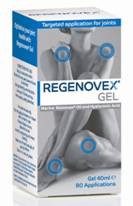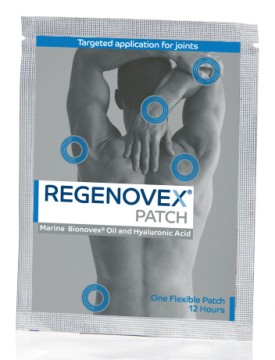The link between bad weather and an increase in discomfort from joint problems has been revealed in new scientific research.
In the UK, about 10 million people suffer from osteoarthritis (OA) and many more have undiagnosed joint stiffness. The prevalence of osteoarthritis increases with age and is greater in women than in men. About 20% of adults aged 45-64 years and 35% of women aged 75 years or over have osteoarthritis in the knee while about 25% of adults over 50 report disability from severe knee discomfort. All too often, the early warning signs and symptoms of joint problems are ignored or just put down to old age, until they become serious and potentially crippling.
People with joint health issues often complain that the weather and climate can badly affect their health. However, scientists have struggled to prove the association and doctors can assume the perception of increased discomfort is in a patient’s mind.
Now new research from the makers of Regenovex® – a pioneering formulation backed by research to help maintain the health of joints – has shone light on the relationship between changes in weather and an increase in joint health problems such as stiffness. Four out of 10 respondents have even considered moving from the UK to a warmer country because of their joint problems. One in nine (11%) are actively contemplating relocation. Containing two functional ingredients from natural sources – a marine oil and hyaluronic acid – Regenovex® Capsules, from the smart technology experts at Mentholatum, is specifically formulated to help keep joints healthy. The Regenovex® range includes one-a-day capsules, a gel and a patch, all containing a marine oil.
Weather misery…
Adults aged 35 to 75 – with an average age of 50 – who suffer from joint health problems or stiffness were questioned about their experiences with weather-related joint issues.
· More than half (55%) said it was during cold periods, followed by damp weather (45%), wet weather (38%) and frosty weather (19%). Just 4% thought hot weather could trigger joint problems.
· A staggering 72% of respondents agreed that they suffered more from joint problems such as discomfort and stiffness because of the weather.
The biggest joint problem symptoms triggered by weather were:
· Discomfort (63%)
· Stiffness (56%)
· Difficulty getting up when seated (30%)
· Difficulty going up or down stairs (24%)
· Difficulty moving (23%).
Other problems included getting out of bed (20%), bending down (17%) and exercising (15%).
When it comes to the areas of the body that are most affected by stiffness, respondents from the Regenovex® survey cited knees as the worst by more than half (56%), followed by the back (39%), the fingers (26%), hips (25%), hands and neck (both 20%).
Reactions to stiffness triggered by the weather varied:
· A third (32%) said they just put up with it and don’t take any further action
· One in seven would take over the counter painkillers (14%)
· 12% would opt for a hot bath
· Other coping strategies included using a hot water bottle (7%) and seeing a GP or pharmacist (5%).
Physiotherapist, Paul Hobrough (pictured) says: “Joint discomfort and joint health issues are a huge problem in the UK, with millions of diagnosed sufferers and many others who struggle on in silence. Joints that are stiff or cause discomfort can badly affect quality of life, with many activities we take for granted proving difficult or even impossible, including the health benefits of taking regular exercise.
“I see a large number of patients in my clinics nationally, that report bad weather or the cold and damp as a trigger for their joint aches or make them worse. For a long time these people have been told that it is in their mind however I was delighted to read the latest research from Regenovex, building on a growing body of evidence, that supports the association between weather – especially temperature and air pressure – and increased levels of joint discomfort and stiffness. The Regenovex survey found nearly three quarters of those questioned said the weather could be a joint health trigger, with cold and damp conditions blamed the most and Scientists are now investigating the mechanisms behind this phenomenon.”
Paul adds: “Regenovex is a new generation of joint care preparation, with a unique formulation that helps to support joint health, backed by extensive scientific research. The key ingredients are Bionovex Oil, a marine oil derived from New Zealand green lipped mussels and hyaluronic acid. The Bionovex Oil has a proven anti-inflammatory effect which could relieve the pressure build up in the joint, while hyaluronic acid acts to lubricate and cushion your joints. Regenovex could be a major help in treating joint health problems. It not only helps tackle inflammation along a range of pathways, but it may also improve and maintain the synovial fluid in joints. No other product works this way.”
“I am thankful to Regenovex for providing a possible answer to scores of patients who have until now, found themselves suffering without a solution. Only time will tell the extent to which Regenovex will help these people but vast progress has been made and people feel like they are finally being listened to by the healthcare industry.”
About Regenovex®
Regenovex® is a technically advanced range of products for joint care from the smart technology experts at Mentholatum. The range includes liquid-filled capsules, readily absorbing gel and a flexible patch. The Regenovex® formulation is a combination of two functional ingredients from natural sources – marine Bionovex® Oil and Hyaluronic acid (HA).

Marine Bionovex® Oil is a pure, patented, marine lipid oil derived from Green Lipped Mussels found only in the waters between North and South islands of New Zealand. This unique Bionovex® Oil ingredient contains polyunsaturated fatty acids (PUFAs) including omega-3 PUFAs. It is particularly rich in eicosatetraenoic acid (ETA), an omega-3 PUFA unique to Green Lipped Mussels.
Bionovex® Oil is produced from a unique proprietary extraction process which results in a high quality oil. Marine lipids have been shown to help encourage the body to produce its own anti-inflammatory agent, lipoxin. They do this by inhibiting two separate inflammatory pathways which involve different enzyme systems known as cyclooxygenase (COX) and lipoxygenase (LOX). But, unlike oral NSAIDs, marine lipids have not been associated with stomach discomfort and gastric bleeding.
Hyaluronic acid (HA) is found naturally in the body in a wide range of tissues, including the joint cartilage. It is also a major component of synovial fluid, the naturally occurring lubricant found in the joints. HA has a variety of functions in the joint, restoring lubrication, providing cushioning, allowing movement and helping to maintain the health of the joint. At low levels of joint impact, such as standing and walking, HA’s properties are primarily lubr
icating.
icating.

At high levels of impact, such as running, football, rugby, hockey, tennis and jumping, HA functions to cushion the joint.
Regenovex® – An A-Z
Regenovex® is available in three unique, technically advanced formulations:
· Regenovex® Capsules. An advanced formulation designed for daily joint health, one-a-day Regenovex® Capsules are very small and easy to swallow.
· Regenovex® Gel is for targeted application on individual joints. Easy to use Regenovex® Gel is dispensed via a pump and can be rubbed on the joint up to 3 times per day.
· Regenovex® Patch is flexible and can be worn for up to 12 hours, making it ideal for day and night use.
Who can use Regenovex®?
· Regenovex® is suitable for adults of all ages and particularly those over 40*.
· Regenovex® Capsules, Gel and the Patch should not be used by pregnant/breastfeeding women or by those allergic to molluscs or shellfish.
· Regenovex is available from most Boots stores (Jointcare or Vitamins & Supplements aisle) nationwide or online at www.boots.com and www.regenovex.co.uk
Prices include:
· Regenovex® Capsules, pack of 30 capsules: RSP £23.99.
· Regenovex® Gel, 40ml: RSP £11.29.
· Regenovex® Patch, single patch: RSP £2.49.
EASING ACHES & PAINS FROM THE OUTSIDE
New research by Deep Relief Gel reveals that 10 million people in Britain suffer pain almost daily, with a quarter (23%) of us taking time off work because of bodily pain. Over 1000 people took part in the study in the UK:
· 88.3% of us experience bodily aches and pains
· 35% of us will experience this daily
· 40% of us would prefer to use a topical pain relieving product rather than taking pills.
· 34.2% worrying about becoming addicted to popping pills
· 21.8% note that they knew someone who has been addicted to pills.
· Back pain is the biggest pain area (73.5%), followed by neck and shoulder pain (61.6%), joint pain (51.5%) and tense muscles (42.9%).
· Topical pain relief gels work differently to pills as they go direct to the site of pain, resulting in far fewer dangers of side effects and work quickly to target the site of pain.
· A new scientific study proves that Deep Relief works faster to relieve pain than other plain Ibuprofen gels on the UK market.
Deep Relief is a topical analgesic with two active pain relieving ingredients. (Available at Tesco and pharmacies nationwide, with an RRP of £5.10 for 50g or £10.20 for 100g).
In clinical trials, topical NSAIDS have been shown to be as effective as oral NSAIDS for relieving the pain of sprains and strains. Deep Relief gel is a topical analgesic containing the NSAID ibuprofen, together with the counter-irritant levomenthol; these two ingredients both treat pain. Ibuprofen reduces inflammation and swelling through the inhibition of the COX pathway and the reduction of inflammatory prostaglandins, this inhibition of prostaglandins helps to block the pain creation mechanism, as prostaglandins are mediations of pain. Levomenthol works by interrupting the pains signals with either sensory stimulus (i.e. cold), which results in the sensation and perception of pain being reduced (Levomenthol is the single active ingredient which is used in 4head). Levomenthol has a synergistic effect with the ibuprofen, which means that the amount of ibuprofen permeating across the skin membrane after 1 and 4 hours from the Deep Relief gel is found to be 2.6 and 1.7 times higher respectively than other topical pain relief gels containing just ibuprofen.



